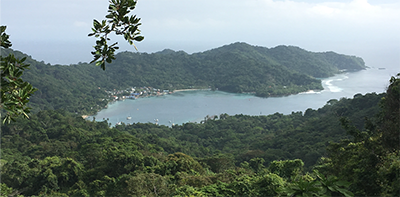Inspired by SGT – At the border between Panama and Colombia
by Erik Salminen
”For the final weeks of my exchange semester in Panama I wanted to do something different. Since even before leaving to Central America there was one location that had always intrigued me, the impassable jungle of the Darién region which separates Panama from Colombia and North-America from the South. The Darién has a rough reputation as it is known for its unpassable rainforest, which creates the only gap on the Pan-American highway, as well as drug traffickers, kidnappings and illegal immigrants. Knowing all this, I still decided to board a small propeller plane from Panama City to the coastal border town of Puerto Obaldía and from there travel by boat and on foot to Colombia. To be honest I had no idea where I was headed, but I was soon to be surprised.
The area I was headed to is widely referred to as the Darién region (or Darién Gap), but this name can be misleading as where I actually went was a part of the indigenous Guna Yala territory (Panamá) and the Colombian department of Chocó. The destination of my flight, Puerto Obaldía is a ramshackle border town on the edge of the Darién rainforest.
My first impression was of a peaceful town where the people live on fishing and money from occasional tourists passing by. I could have stayed longer but I wanted to keep my momentum, so I ended up taking a boat ride all the way to Colombia (15 minutes) to the town of Capurganá, where I could visit the authorities to validate my border crossing and then be free to travel in the region. This all went smoothly, but Capurganá felt a little too much for me so I ended up taking another boat back to the Colombian border town of Sapzurro.

Then I fell in love. I fell in love with the peace and the quiet. The beautiful secluded beaches and the imposing Darién rainforest creeping into the tiny town, the way that after three days the townspeople already recognized me, the general friendliness of everyone but also the fact that no one was trying to hoard me with tourist excursions or cheap meals. After the high-octane life in Panama City this was a perfect place to just be for a while. From Sapzurro you can cross the border to the even smaller town of La Miel in Panama. The walk is a 500 meter up and down walk to a hill with the border station located on the top. The border guards (if they are there) are incredibly relaxed and according to the ones I talked to, they only really need to worry about illegal immigrants crossing the border as the drug trade and civil war factions are operating far away in the middle of the region. I stayed three nights in Sapzurro and ended up talking with the hostel owner’s husband who is a collaborator with the Communal Action Board. He brought to my attention issues and ideas for the town and ways in which a possible student led project could help the area.
We discussed the three main challenges of Sapzurro:
- Water treatment and the lack of it (the source is a river flowing from the jungle to the town, with a collection point approximately 500 m upstream)
- Electricity shortages
- Waste collection
According to our discussions, it seems that the water collection of the town is in urgent need of rehabilitation even though the townspeople in general don’t seem to be concerned. The aqueduct and collection point were built 60 years ago and have not been serviced recently causing water related diseases to be in the rise. Wastewater from toilets is usually treated in septic tanks, but shower and kitchen water go straight to the sea. To top it off, there are dangerous animals in the jungle, so when hiking up to the water collection point, it is important to be mindful of serpents and spiders.
We also agreed that education towards recycling and circular economy is crucial. Even though there is supposedly a scheme to recycle plastic bottles in Sapzurro, I could not see any signs of it. Also, a source of renewable energy is needed (solar or wind) as the energy from Capurganá is unreliable despite government promises. During my 3-day stay, I encountered multiple shortages, albeit not very long ones.
I don’t know if a student project in this area is possible and I was careful to tell the locals that I am not making any promises as I was just investigating the possibilities. Whatever happens, the site is incredible and has lot to offer.”
Writer participated in SGT Studio course in Tanzania in 2017. His team worked with the urban poor communities in Dar es Salaam to develop sanitation systems and fertilizer production. After the course, he spent 6 months in Panamá as an exchange student before finalizing his master’s degree in Water and Environmental Engineering at Aalto. These are his observations from one incredible place in the border of Panamá and Colombia.